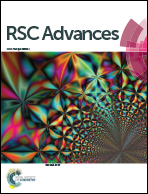Fast and highly efficient purification of 6×histidine-tagged recombinant proteins by Ni-decorated MnFe2O4@SiO2@NH2@2AB as novel and efficient affinity adsorbent magnetic nanoparticles†
Abstract
The present study is aimed at the synthesis of MnFe2O4@SiO2@NH2@2AB-Ni, as a highly efficient and novel affinity adsorbent, for specific purification of 6×histidine-tagged recombinant proteins. The new immobilized metal ion affinity adsorbent was fabricated following co-precipitation synthesis of superparamagnetic manganese ferrite nanoparticles. Subsequently, tetraethyl orthosilicate (TEOS) was added in weak basic conditions (pH ∼ 9) to prevent oxidation and increase the density of –OH groups on the surface of MnFe2O4. Synthesized MnFe2O4@SiO2 was then properly NH2-functionalized with 3-aminopropyl-trimethoxylsilane (APTMS) as anchor molecules. Manganese ferrite nanoparticles were converted to bidentate ligands through a reaction between isatoic anhydride and amino-functionalized MnFe2O4@SiO2. The stable surface functionalized nanoparticles were further linked with Ni2+ and used in powder form for efficient purification of 6×His-tagged proteins from the mixture of lysed cells. MnFe2O4@SiO2@NH2@2AB-Ni nanoparticles exhibited excellent performance in the separation of 6×histidine-tagged recombinant protein-A from cell lysate, with a binding capacity of about 220 mg g−1. Indeed, the synthesized magnetic nanoparticles presented negligible nonspecific protein adsorption.


 Please wait while we load your content...
Please wait while we load your content...